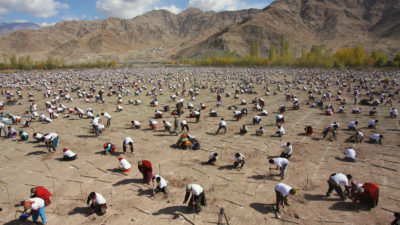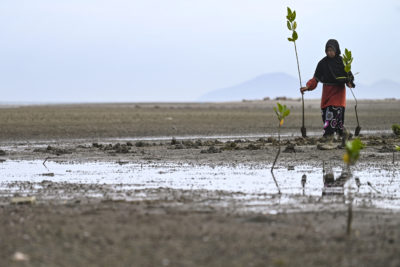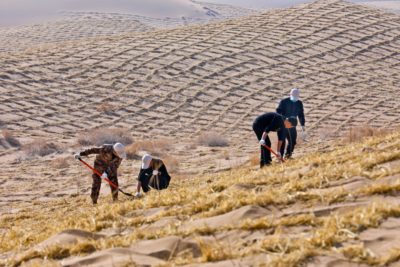Of course, most are failing simply because fools rush in where angels do not thread. It is too easy to sell and even recruit volunteers. Even the Green party could organize a tree planting bee.
Do look at Groasis to understand what the future really demands. also understand that someone reponsible needs to own these trees. Or you wake up to find your forest is now firewood. That has happened way more than once.
Yet were the culure understands we have increasing success such as the Sahel and Ethiopia. So it can be done even were difficult and swith technology such as Groasis we can do much better.
What is key is that the MEME itself is global.
Phantom Forests: Why Ambitious Tree Planting Projects Are Failing
More than 9,000 people in Leh, India planted more than 50,000 tree saplings in under an hour on October 10, 2010.
https://e360.yale.edu/features/phantom-forests-tree-planting-climate-change?
High-profile initiatives to plant millions of trees are being touted by governments around the world as major contributions to fighting climate change. But scientists say many of these projects are ill-conceived and poorly managed and often fail to grow any forests at all.
BY FRED PEARCE • OCTOBER 6, 2022
It was perhaps the most spectacular failed tree planting project ever. Certainly the fastest. On March 8, 2012, teams of village volunteers in Camarines Sur province on the Filipino island of Luzon sunk over a million mangrove seedlings into coastal mud in just an hour of frenzied activity. The governor declared it a resounding success for his continuing efforts to green the province. At a hasty ceremony on dry land, an official adjudicator from Guinness World Records declared that nobody had ever planted so many trees in such a short time and handed the governor a certificate proclaiming the world record. Plenty of headlines followed.
But look today at the coastline where most of the trees were planted. There is no sign of the mangroves that, after a decade of growth, should be close to maturity. An on-the-ground study published in 2020 by British mangrove restoration researcher Dominic Wodehouse, then of Bangor University in Wales, found that fewer than 2 percent of them had survived. The other 98 percent had died or were washed away.
“I walked, boated, and swam through this entire site. The survivors only managed to cling on because they were sheltered behind a sandbank at the mouth of a river. Everything else disappeared,” one mangrove rehabilitation expert wrote in a letter to the Guinness inspectors this year, which he shared with Yale Environment 360 on the condition of anonymity. The outcome was “entirely predictable,” he wrote. The muddy planting sites were washed by storms and waves and were otherwise “ecologically unsuited to mangrove establishment, because they are too waterlogged and there is no oxygen for them to breathe.”
Researchers found little evidence that government-led planting in India resulted in more tree cover, carbon uptake, or community benefits.
“It was a complete disaster,” agrees Jim Enright, former Asia coordinator of the U.S.-based nonprofit Mangrove Action Project. “But no one that we know of from Guinness or the record-planting proponents have carried out follow-up monitoring.” Guinness has not responded to requests for comment.
Such debacles are not unusual. Forest scientists say they are surprisingly frequent, and they warn that failed afforestation projects around the world threaten to undermine efforts to make planting a credible means of countering climate change by reducing carbon dioxide in the atmosphere or generating carbon credits for sale to companies to offset their emissions.
NEVER MISS AN ARTICLE
Subscribe to the E360 Newsletter for weekly updates delivered to your inbox. Sign Up.
In another high-profile case, in November 2019, the Turkish government claimed to have planted more trees on dry land than anyone else in a single hour — 300,000, in the central province of Çorum. It beat a record, also confirmed by Guinness inspectors, set four years before in the Himalayan state of Bhutan. The Çorum planting was part of a National Afforestation Day, when volunteers planted 11 million trees at 2,000 sites across Turkey. President Recep Tayyip Erdoğan was among those wielding a spade.
But two months later, the head of the country’s union of forestry workers reported that a survey by its members had found that as many as 90 percent of the national plantings had died. The government denies this, but experts said its counter-claim that 95 percent of the trees had survived and continued to grow was improbably high. No independent audit has yet been carried out.
A villager in Peukan Bada, Indonesia plants mangrove trees. CHAIDEER MAHYUDDIN / AFP VIA GETTY IMAGES
In an investigation published last year into extensive government-organized tree planting over several decades in the northern Indian state of Himachal Pradesh, Eric Coleman of Florida State University and colleagues found little evidence that it had resulted in more tree cover, carbon uptake, or community benefits. Typically, tree species growing on common land that were useful to local people for animal fodder and firewood had been replaced by plantations of fast-growing but less useful trees, often fenced off from local communities.
Another study, published last year by the nonprofit World Resources Institute (WRI) in Mexico, called into question the benefits from a billion-dollar government-funded environmental recovery program. Sembrando Vida pays farmers to plant trees across the country to help Mexico meet its climate targets under the Paris Agreement. But WRI found the program has no effective audit of outcomes, and that rates of forest loss were currently greater in states implementing the plan than in others. It concluded that the program “could have had a negative impact on forest cover and compliance with the country’s carbon mitigation goals.”
Tree planting in the Philippines under its National Greening Program has also been a widespread failure, according to a 2019 study by the government’s own Commission on Audit. Ministers imposed unachievable planting targets, it said, resulting in planting “without … survey, mapping and planning.” The actual increase in forest cover achieved was little more than a tenth of that planned.
Unanimity of support for tree planting may reduce the impetus for critical analysis of what is achieved at each project.
The causes of failure vary but include planting single species of trees that become vulnerable to disease; competing demands for the land; changing climate; planting in areas not previously forested; and a lack of aftercare such as watering saplings.
Everybody likes trees. There is no anti-tree lobby. A global push to go beyond conservation of existing forests and start creating new ones goes back to 2011, when many of the world’s governments, including the United States, signed up to the Bonn Challenge, which set a goal of restoring some 860 million acres of forest globally by 2030. That is an area bigger than India, and enough to soak up 1.7 billion tons of carbon dioxide annually, adding almost a quarter to the current estimated forest carbon sink.
In 2020, at its annual meeting in Davos, Switzerland, the World Economic Forum launched One Trillion Trees, an initiative aimed at adding a third to the world’s current estimated inventory of around 3 trillion trees. Even Donald Trump got behind the push, promising to plant a billion trees across the U.S.
But the very unanimity of support for tree planting may reduce the impetus for detailed audits or critical analysis of what is actually achieved at each project. The paucity of follow-up thus far has resulted in a great deal of wasted effort – and money.
Volunteers plant trees at the edge of China's Badain Jaran Desert last year. WANG JIANG / VCG VIA GETTY IMAGES
Every year, “millions of dollars” are spent on reforesting landscapes, according to Lalisa Duguma of World Agroforestry, an international research agency in Nairobi, Kenya. Yet “there are few success stories.” Typically only a minority of seedlings survive, he says, because the wrong trees are planted in the wrong places, and many are left untended, in part because ownership and management of trees is not handed over to local communities.
Such failures often go unnoticed, believes Duguma, because performance indicators measure planting rates not survival rates, and long-term oversight is minimal because projects typically last three years or less. The result is “phantom forests.”

ALSO ON YALE E360
A big new forest initiative sparks concerns of a ‘carbon heist.’ Read more.
The record for restoring mangroves along coastlines, often in an effort to hold back coastal erosion from storms and rising tides, is especially bad. An analysis last year by the Netherlands-based NGO Wetlands International, which had previously sponsored mangrove planting, concluded that “while many tens of millions of euros have been spent on mangrove restoration in recent years, the majority of these restoration projects has failed. With success rates ranging between 15-20%, a lot of conservation funding has gone to waste.” It blamed poor planting methods and the wrong species planted in the wrong places.
Most planting across Southeast Asia has been of Rhizophora red mangroves. Their cuttings are easy to harvest from existing trees and to plant. Typically, they are planted in tidal mudflats, which ensures no competing land uses, but most are starved of oxygen or washed away by constant inundation at high tide, according to an analysis by Shing Yip Lee of the Chinese University of Hong Kong.
Even the best-planned planting projects can come undone, leaving behind non-existent forests and uncaptured carbon.
The government of Sri Lanka launched a mass mangrove planting program around its shores to help prevent a repeat of the disastrous loss of life there during the 2004 Indian Ocean tsunami. But the program has turned out to be an abysmal failure. “Nine out of 23 project sites … showed no surviving plants,” according to a 2017 study by Sunanda Kodikara of the University of Ruhuna. “Only three sites showed a level of survival higher than 50 percent.”
Too often, argues Duguma, tree planting is “greenwashing” aimed at grabbing headlines and promoting an image of governments or corporations as environmentally friendly. Tiina Vahanen, deputy director of forestry at the UN’s Food and Agriculture Organization, noted recently that many projects end up being little more than “promotional events, with no follow-up action.”
Cynical PR is one thing, but phantom forests are also increasingly sabotaging efforts to rein in climate change. This happens when planters claim the presumed take-up of carbon by growing forests as carbon credits. If certified by reputable bodies, these credits can count toward governments meeting their national emissions targets or be sold to industrial polluters to offset their emissions. Many corporations plan to use their purchase of carbon credits as a means of fulfilling promises to attain “net-zero” emissions. So the stakes are rising.
But even the best-planned and best-audited planting projects can come undone, leaving behind non-existent forests and uncaptured carbon. The California Air Resources Board (CARB) is a major certifier of carbon-offset forests across the American West. It approves the carbon credits generated by the forests, which are then sold to industrial polluters in California who want to offset their emissions in line with state regulations.
Trees blackened by the 2021 Bootleg Fire in Oregon, which burned through woodlands providing Microsoft with carbon offsets. NATHAN HOWARD / AP
But climate change is leaving the western U.S. increasingly vulnerable to wildfires — raising serious questions about the viability of the forests and the credibility of their carbon credits.
To meet this challenge, CARB requires offset developers to hold back from sale a proportion of the credits, which they put into a central buffer fund as insurance against a variety of potential mishaps during the 100-year planned lifetime of the offsets. Up to 4 percent of credits insure against wildfires. That buffer fund picked up the tab, for instance, when 99 percent of the carbon in a forest offset project on Eddie Ranch in Northern California burned in a fire in 2018.
But the CARB certification system is running out of buffer carbon, according to an analysis published in August by ecologist Grayson Badgley at CarbonPlan, a nonprofit climate solutions database. He found that just seven years into its supposed century-long insurance, 95 percent of the wildfire buffer has been consumed by just six fires across the West. CARB says that certifying more forests will grow the buffer account and prevent a default. But Danny Cullenward, an environmental lawyer at American University in Washington, D.C. and co-author of the CarbonPlan analysis, calls this “a giant Ponzi scheme.”
He says the problem of undercapitalized buffer accounts for carbon is widespread among the hundreds of markets set up internationally to certify and trade carbon offsets for corporate clients. They have “essentially no regulatory requirements and operate instead on loose private standards,” he says.
Forest ecologists say creating space to allow nature to do its thing is usually a better approach to restoring forests than planting.
Those private standards are likely to be increasingly inadequate, says forest ecologist William Anderegg of the University of Utah, who estimated recently that climate change will make wildfires four times more likely across the American West by the end of the century, raising “serious questions about the integrity of [offset] programs.”
Besides climate change and wildfires, another major problem for forest planters is bad relations with locals. In a global survey of organizations involved in forest restoration, Markus Höhl of the University of Gottingen found widespread concern about a lack of buy-in from forest communities. Project promoters did not ask the local people what trees they wanted, or where they should be planted.
Not surprisingly, those locals often reacted badly. For example, in northern Malawi, they broke fences and burned a growing forest to get back the common grazing land on which the trees had been planted. In two Nigerian projects, villagers cut all the planted non-fruit trees for firewood, while protecting those that bore fruit.
Forest planting can work if the social and environmental conditions are right, and if planting is followed by long-term monitoring and aftercare of the trees. There has been substantial regrowth of the Brazil’s Atlantic Forest following a joint initiative of the government and private sector. But even here progress has been haphazard and much of the increase has been a result of natural regeneration rather than planting.

MORE ON YALE E360
Will Russia’s forests be an asset or obstacle in the climate fight? Read more.
In fact, many forest ecologists say creating space to allow nature to do its thing is usually a better approach to restoring forests than planting. “Allowing nature to choose which species predominate … allows for local adaptation and higher functional diversity,” argues one advocate, Robin Chazdon of the University of Connecticut, in her book Second Growth. For mangroves, Wetlands International now recommends abandoning widespread planting and instead creating areas of slack water along coastlines, where mangroves can naturally reseed and grow.
Ashwini Chhatre, an expert in forest governance at the Indian School of Business in Hyderabad, is not alone in saying that “after three decades of walking through planted forests … it is surprising any are successful at all.”




No comments:
Post a Comment